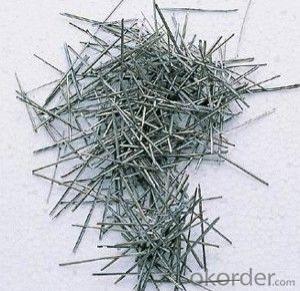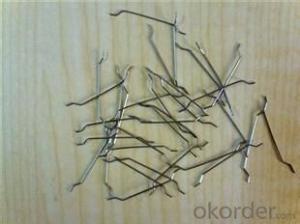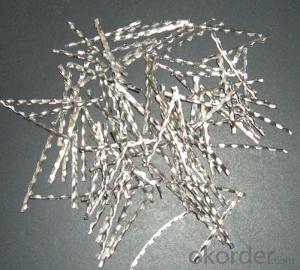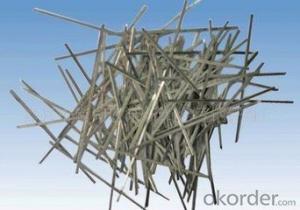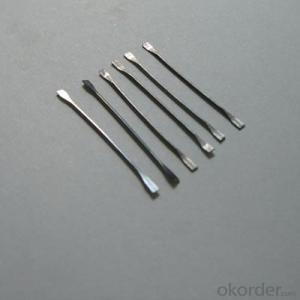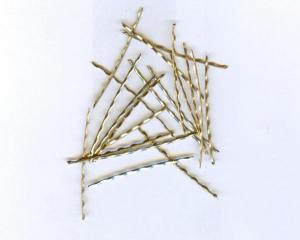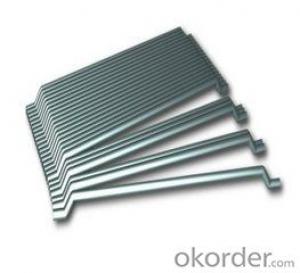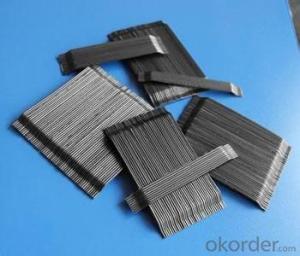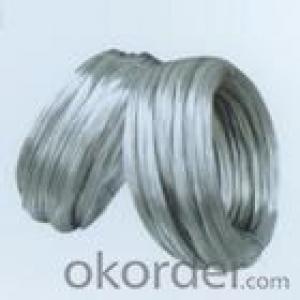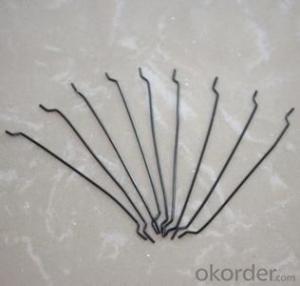China supplier concrete steel fiber From CNBM
- Loading Port:
- Tianjin
- Payment Terms:
- TT OR LC
- Min Order Qty:
- 1 m.t.
- Supply Capability:
- 600 m.t./month
OKorder Service Pledge
Quality Product, Order Online Tracking, Timely Delivery
OKorder Financial Service
Credit Rating, Credit Services, Credit Purchasing
You Might Also Like
Quick Details
Place of Origin: Tianjin, China (Mainland)
Model Number: 0.55
Material: Steel
Production Process: Cold drawn
Fiber Lengh: 35
Type: 1
Compressive Strength: >1200MPa
Aspect ratio: 63
Standard: ASTM A820M-11
Section Shape: Circular
Application: Concrete Reinforcement
Product Application: Industrial Floor
Packaging & Delivery
| Packaging Details: | 20 kg/Bag,50 bags/Pallet or 1,000kg/ Bulk Bag |
|---|---|
| Delivery Detail: | 1 Month |
Product Description
| Diameter | 0.55 mm (0.217 in) | ||
| Length | 35 mm (13.780 in) | ||
| Aspect Ratio | 63 | ||
| Tensile strength | 1200 MPa | ||
| Type | Cold drawn Steel Fiber | ||
| End | Hooked-end Steel Fiber | ||
| Glued/Loose | Glued Steel Fiber | ||
| Bending Angle | 45°(min.30°) | ||
| Usage & Performance | Floor:Trafficked areas and Industrial floors | ||
| Shotcrete :Slope stabilization and Final lining | |||
| Precast concrete:Pipe and Railway sleepers | |||
| Packing | Standard Export Pallet Packing | Bag Packing | 20 kg/Bag,50 bags/Pallet |
| Bulk Packing | 1,000kg/ Bulk Bag | ||
| Loading Quantity | 20’GP | 20-25 Tonne/Tonnes | |
| 40’GP | 25-27 Tonne/Tonnes | ||
| 40’HQ | 25-27 Tonne/Tonnes | ||
| MOQ | 1 kg for trial order | ||
| Supply Ability | 10,000 Tonne/Tonnes per Year | ||
| Payment Terms | T/T or L/C at sight | ||
| Delivery Time | Within 15 days after receiving deposit or original L/C at sight | ||
| Certification | ISO9001:2000, CE, | ||
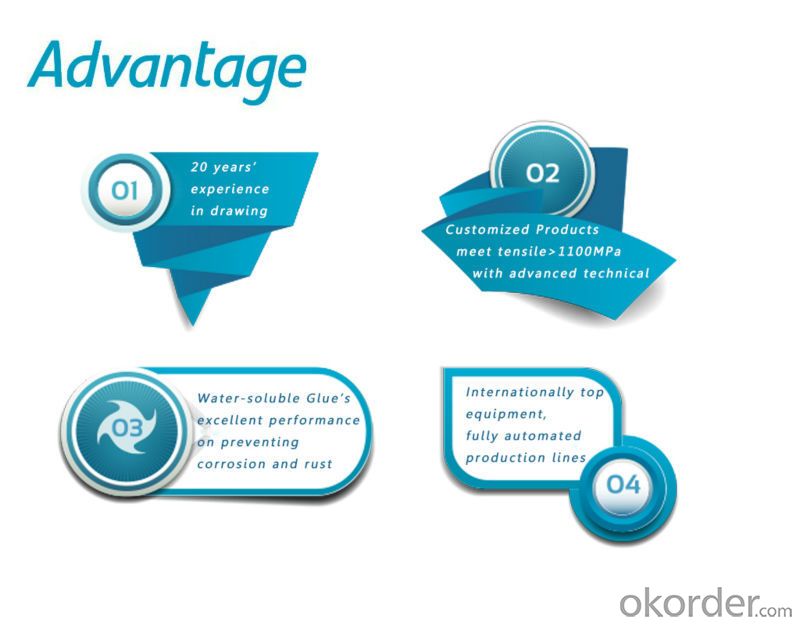
| Product | Diameter | Length mm/in | Aspect Ratio | Type | Packing |
| G-6030 | 0.5 mm (0.197 in) | 30 mm (11.811 in) | 60 | Glued | 20 kg/Bag, or 1,000kg/ Bulk Bag |
| G-6535 | 0.55 mm (0.217 in) | 35 mm (13.780 in) | 65 | Glued | 20 kg/Bag, or 1,000kg/ Bulk Bag |
| G-6035 | 0.6 mm (0.236 in) | 35 mm (13.780 in) | 60 | Glued | 20 kg/Bag, or 1,000kg/ Bulk Bag |
| G-8060 | 0.75 mm (0.295 in) | 60 mm (23.622 in) | 80 | Glued | 20 kg/Bag, 50 bags/Pallet |
| G-6060 | 0.9 mm (0.354 in) | 60 mm (23.622 in) | 60 | Glued | 20 kg/Bag, 50 bags/Pallet |
| G-6030 | 0.5 mm (0.197 in) | 30 mm (11.811 in) | 60 | Loose | 20 kg/Bag, or 1,000kg/ Bulk Bag |
| G-6535 | 0.55 mm (0.217 in) | 35 mm (13.780 in) | 65 | Loose | 20 kg/Bag, or 1,000kg/ Bulk Bag |
| G-6035 | 0.6 mm (0.236 in) | 35 mm (13.780 in) | 60 | Loose | 20 kg/Bag, or 1,000kg/ Bulk Bag |
| G-8060 | 0.75 mm (0.295 in) | 60 mm (23.622 in) | 80 | Loose | 20 kg/Bag, 50 bags/Pallet |
| G-6060 | 0.9 mm (0.354 in) | 60 mm (23.622 in) | 60 | Loose | 20 kg/Bag, 50 bags/Pallet |
- Q:Does melt extract stainless steel fiber improve the flexural strength of concrete?
- Yes, melt extract stainless steel fiber does improve the flexural strength of concrete. This type of fiber is manufactured by melting stainless steel and then extracting it into thin fibers. These fibers are added to concrete mixtures to enhance its mechanical properties, including flexural strength. When melt extract stainless steel fibers are mixed into concrete, they act as reinforcement by distributing stresses more evenly throughout the material. This helps to prevent cracking and increase the overall strength of the concrete in bending or flexural conditions. Additionally, the high tensile strength and ductility of stainless steel fibers further contribute to the improved flexural strength of concrete. These fibers can effectively resist the tensile forces that occur during flexural loading, resulting in a more durable and resilient concrete structure. Overall, the incorporation of melt extract stainless steel fibers in concrete significantly enhances its flexural strength, making it a popular choice for various applications such as pavements, industrial floors, and structural elements subjected to bending or flexural forces.
- Q:How does melt extract stainless steel fiber affect the rheology of self-compacting shotcrete?
- Melt extract stainless steel fiber can have a significant impact on the rheology of self-compacting shotcrete. Firstly, the addition of stainless steel fibers can improve the overall viscosity and fluidity of the shotcrete mix. The fibers act as a reinforcement and help to maintain the stability and flowability of the mix, preventing segregation and settlement during application. This is particularly important in self-compacting shotcrete, where a high degree of workability is required to ensure proper consolidation and filling of the desired areas. Moreover, the stainless steel fibers also enhance the cohesion and cohesiveness of the shotcrete mix. The fibers act as a bonding agent, improving the interparticle interactions and increasing the overall strength and durability of the shotcrete. This results in a more cohesive and stable material that is less prone to cracking and shrinkage. Additionally, the presence of stainless steel fibers can also impact the setting time of the shotcrete. The fibers can accelerate the hydration process and promote the early development of strength. This is beneficial in self-compacting shotcrete applications where rapid setting and early strength development are desired to allow for faster construction progress. Furthermore, the melt extract stainless steel fibers can also contribute to the overall ductility and toughness of the shotcrete. The fibers provide additional resistance against crack propagation and enhance the overall structural integrity of the material. This is crucial in self-compacting shotcrete, as it allows for better performance under dynamic loading conditions and enhances the ability of the material to withstand external forces. Overall, the melt extract stainless steel fibers have a positive effect on the rheology of self-compacting shotcrete by improving viscosity, cohesion, setting time, and overall durability. Their addition enhances the workability and performance of the shotcrete, making it a highly suitable material for various construction applications.
- Q:Can melt extract stainless steel fiber be used in composite materials or fiber-reinforced polymers?
- Yes, melt extract stainless steel fiber can be used in composite materials or fiber-reinforced polymers. Stainless steel fibers are known for their high strength, corrosion resistance, and thermal stability, making them suitable reinforcements for various applications. In composite materials or fiber-reinforced polymers, stainless steel fibers can enhance the mechanical properties, such as tensile strength, stiffness, and impact resistance. They can also improve the durability and dimensional stability of the composite material. Additionally, the electrical conductivity of stainless steel fibers can be advantageous in certain applications. Overall, the use of melt extract stainless steel fiber in composite materials or fiber-reinforced polymers can provide improved performance and functionality.
- Q:Is melt extract stainless steel fiber compatible with all types of admixtures?
- Melt extract stainless steel fiber generally works well with most admixtures used in concrete. However, it's important to note that compatibility can vary depending on the specific type and dosage of the admixture, as well as the intended application and performance requirements of the concrete. Stainless steel fibers are usually chemically inert and don't react with most admixtures, making them generally compatible. They can be used alongside different types of admixtures, such as water reducers, air entraining agents, accelerators, retarders, and superplasticizers. Nevertheless, it's crucial to refer to the manufacturer's recommendations and conduct compatibility tests to ensure the admixture being used is compatible with stainless steel fibers. Some admixtures may have specific guidelines or limitations when used with fibers. Admixture manufacturers can offer guidance on the compatibility and any potential impact on performance. Furthermore, it's important to consider the purpose and desired properties of the concrete. Stainless steel fibers can enhance mechanical properties like flexural strength, toughness, and durability. However, specific admixtures designed for corrosion inhibition or shrinkage reduction may have different requirements or limitations when combined with stainless steel fibers. To summarize, while melt extract stainless steel fiber is generally compatible with most admixtures, it's crucial to consult the manufacturer's recommendations and conduct compatibility tests for optimal performance and to avoid potential issues.
- Q:Can melt extract stainless steel fiber be used in underground utility structures?
- Underground utility structures can make use of melt extract stainless steel fiber. These fibers are well-known for their exceptional resistance to corrosion, impressive strength, and long-lasting nature. These qualities make them appropriate for a range of applications, including underground utility structures. When incorporated into underground utility structures, melt extract stainless steel fiber provides additional reinforcement to the concrete matrix. This reinforcement works to improve the overall structural integrity and load-bearing capacity of the structures, resulting in an extended lifespan. Moreover, stainless steel fibers are highly resistant to chemical attacks and can endure the harsh conditions found underground, such as exposure to moisture, chemicals, and different soil conditions. This reliability makes them an excellent choice for reinforcing underground utility structures that may face these challenging circumstances. Aside from their corrosion resistance, stainless steel fibers also exhibit outstanding resistance to temperature changes. This characteristic is particularly crucial for underground utility structures, which may experience fluctuations in temperature due to weather changes or the heat generated by the utilities themselves. In conclusion, melt extract stainless steel fiber is a suitable option for reinforcing underground utility structures. Its corrosion resistance, high strength, durability, and ability to withstand harsh underground conditions make it an ideal material for enhancing the performance and prolonging the lifespan of these structures.
- Q:Can melt extract stainless steel fiber be used in water treatment plants?
- Yes, melt extract stainless steel fiber can be used in water treatment plants. It is commonly utilized in various processes such as filtration, sedimentation, and sludge dewatering due to its corrosion resistance and high strength properties. The stainless steel fiber helps to improve the efficiency and effectiveness of water treatment processes by enhancing filtration, reducing clogging, and increasing the lifespan of equipment.
- Q:Can melt extract stainless steel fiber be used in bicycle lane pavements?
- Yes, melt extract stainless steel fiber can be used in bicycle lane pavements. Stainless steel fibers are often added to concrete mixtures to increase its strength and durability. They enhance the concrete's resistance to cracking, impact, and fatigue, making it an ideal material for bicycle lane pavements. The stainless steel fibers also improve the concrete's resistance to corrosion, which is important for outdoor applications. Additionally, the fibers help to distribute stresses more evenly throughout the pavement, reducing the risk of surface cracks and potholes. Overall, melt extract stainless steel fibers can be a beneficial addition to bicycle lane pavements, improving their longevity and performance.
- Q:What is the typical fiber length of melt extract stainless steel fiber?
- The typical fiber length of melt extract stainless steel fiber can vary depending on the specific product and manufacturer. However, on average, melt extract stainless steel fibers typically have a fiber length ranging from 3 mm to 25 mm. This length is suitable for various applications, such as reinforcement of concrete and other composite materials, thermal insulation, and electromagnetic shielding. It is important to note that different industries and uses may have specific requirements for fiber length, so it is always recommended to consult the manufacturer or supplier for the exact specifications needed for a particular project.
- Q:The heavy steel fiber feifanshi supeiflat floor for what?
- A production or storage center with higher load requirements
- Q:Can melt extract stainless steel fiber be used in airport runways or taxiways?
- Yes, melt extract stainless steel fiber can be used in airport runways or taxiways. Stainless steel fibers are known for their high strength and durability, making them suitable for heavy-duty applications like airport pavements. They can help improve the resistance to cracking and enhance the overall performance and lifespan of the runway or taxiway.
1. Manufacturer Overview |
|
|---|---|
| Location | |
| Year Established | |
| Annual Output Value | |
| Main Markets | |
| Company Certifications | |
2. Manufacturer Certificates |
|
|---|---|
| a) Certification Name | |
| Range | |
| Reference | |
| Validity Period | |
3. Manufacturer Capability |
|
|---|---|
| a)Trade Capacity | |
| Nearest Port | |
| Export Percentage | |
| No.of Employees in Trade Department | |
| Language Spoken: | |
| b)Factory Information | |
| Factory Size: | |
| No. of Production Lines | |
| Contract Manufacturing | |
| Product Price Range | |
Send your message to us
China supplier concrete steel fiber From CNBM
- Loading Port:
- Tianjin
- Payment Terms:
- TT OR LC
- Min Order Qty:
- 1 m.t.
- Supply Capability:
- 600 m.t./month
OKorder Service Pledge
Quality Product, Order Online Tracking, Timely Delivery
OKorder Financial Service
Credit Rating, Credit Services, Credit Purchasing
Similar products
New products
Hot products
Hot Searches
Related keywords
